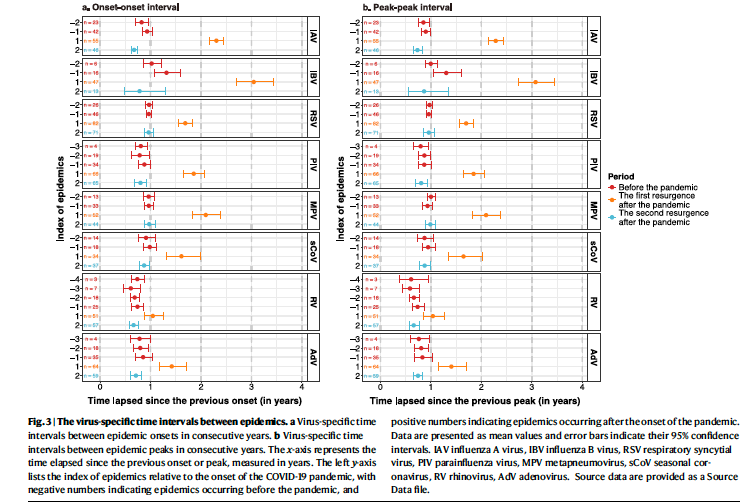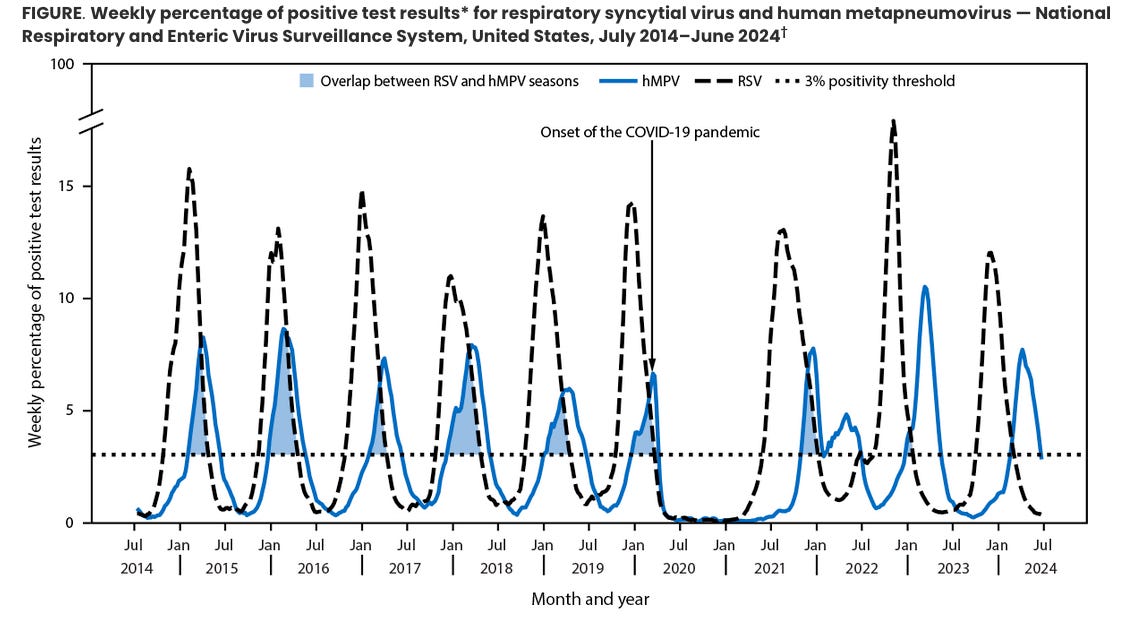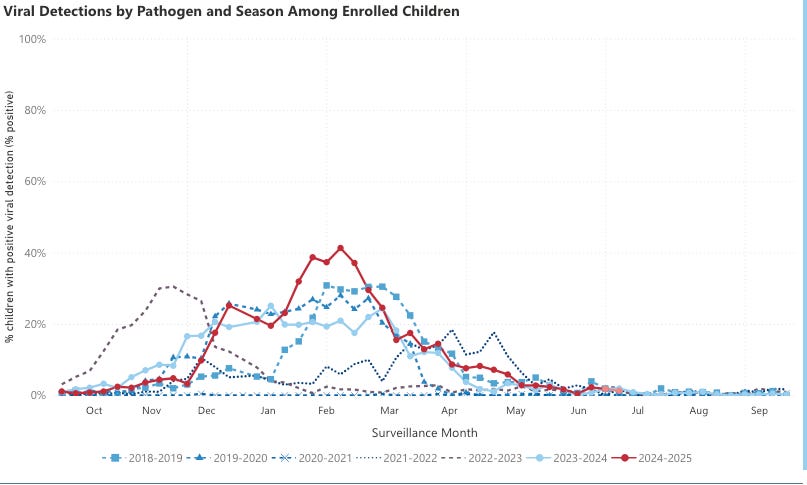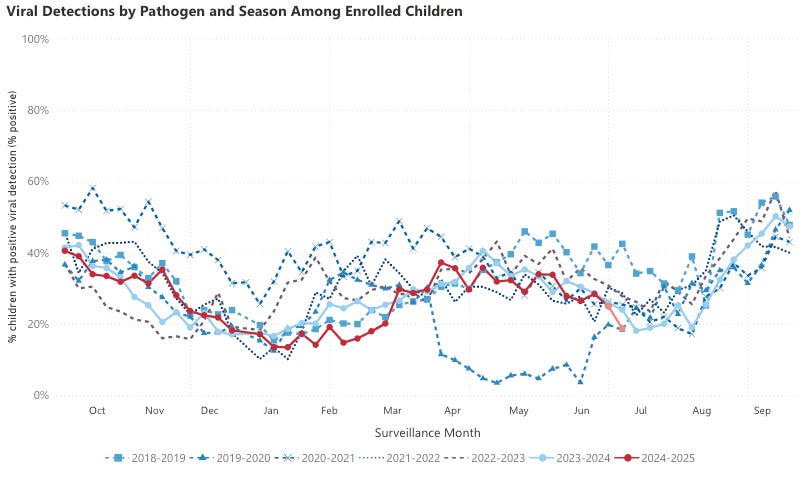TL;DR: COVID disrupted the timing of many seasonal viruses for a year or two, but things have largely returned to pre-pandemic patterns.
A friend recently noted the high prevalence of summer viruses among the kids in his life, and wondered whether COVID was still messing up the seasonality of the many circulating bugs out there. I wasn’t sure, but took the chance to dig into the data.
I was already aware of the remarkable fact that influenza all but disappeared from circulation during the first two years of the pandemic, and one entire influenza B lineage went extinct and has now been removed from our annual flu shots. (And yes, this feels like good evidence to me that precautions like social distancing do in fact reduce the transmission of infectious diseases).
Source: Our World in Data.
But flu wasn’t the only virus to disappear for a bit during COVID. Disruptions were also seen for other common respiratory viruses like respiratory syncytial virus (RSV), parainfluenza virus (PIV), metapneumovirus (MPV), seasonal coronaviruses (sCoV), and rhinovirus (RV).
A recent paper examined data from 31 countries and summarized the changes in the timing of the resurgence of these viruses after the COVID pandemic:
Source: Zhao, C., Zhang, T., Guo, L. et al. Characterising the asynchronous resurgence of common respiratory viruses following the COVID-19 pandemic. Nat Commun 16, 1610 (2025).
The researchers found significant delays in the return of most viruses for the first time after the onset of the pandemic, but thereafter, the “periodicity” or time between major waves reverted back to pre-pandemic intervals.
These data shows that the intervals between waves have mostly gone back to normal for the most common respiratory viruses, but what about the timing? Here, we can look at some specific viruses over time to get the picture.
Source: Jobe NB, Rose E, Winn AK, Goldstein L, Schneider ZD, Silk BJ. Human Metapneumovirus Seasonality and Co-Circulation with Respiratory Syncytial Virus — United States, 2014–2024. MMWR Morb Mortal Wkly Rep 2025;74:182–187. DOI: http://dx.doi.org/10.15585/mmwr.mm7411a1
We can see in the figure above that after skipping its typical December peak in 2020, RSV returned with an unusually long wave starting in the Spring of 2021 that peaked in July. This was followed by an earlier (and higher) peak in early November 2022 before moving towards more typical winter peaks thereafter. Human metapneumovirus also skipped a season before resurging with an odd double peak, followed by a return to more normal timing.
Going back to flu, the US saw an abnormal 2021-2022 season with low but persistent levels in the winter and an unusual increase in the Spring. The 2022-2023 season returned to more typical levels but with activity starting and peaking very early in the fall. The last two flu seasons have seen a shift back to the more normal timing of January and February peaks:
Influenza detections from sentinel surveillance for acute respiratory illnesses in US children aged less than 18 years old. Source: US CDC Pediatric Acute Respiratory Illness (ARI) Interactive Dashboard
Rhinovirus (the most common cause of the “common” cold) dropped to low levels in the first months of the pandemic but was among the first viruses to come roaring back, before quickly settling back into typical patterns:
Rhinovirus/Enterovirus detections from sentinel surveillance for acute respiratory illnesses in US children aged less than 18 years old. Source: US CDC Pediatric Acute Respiratory Illness (ARI) Interactive Dashboard
If you are nerdy enough to want to check out the patterns for other viruses you can play around with the US pediatric surveillence dashboard here.
It turns out that globally, there was a pretty consistent sequential order of resurgence of these common respiratory viruses after disruption from COVID precautions, with rhinoviruses, RSV, seasonal coronaviruses, adenoviruses, and parainfluenza viruses having earlier resurgences and human metapneumoviruses and flu returning later. This consistency points to the likely importance of virus-specific factors such as the duration of immunity (generally short for rhinoviruses) and the intrinsic transmissibility of the viruses- the more contagious the virus, the more it could keep circulating at low levels and start speading again when precautions were eased.
Please don’t call it “immunity debt”
A final side note-you may have noticed that the first or second resurgence of some of these viruses was higher than typical peaks. Some claimed this was due to an “immunity debt” from reduced transmission during periods of COVID precautions. For populations, it’s true that we likely saw some “catch-up” from previous low transmission. But “debt” is a bad choice of words, as there is no fixed number of infections we “owed” that must be paid back. With transmission disrupted, population immunity to other viruses dropped as fewer people were recently exposed, increasing the pool of “susceptibles”. It was not surprising to see temporarily higher than average levels of these viruses as social interactions returned to normal, but this does not mean a lack of viral exposures weakened our immune systems. It also doesn’t mean that the overall benefits of reduced circulation of these viruses during COVID were canceled out. Read more here:
So to my friend surrounded by lots of sick kids this summer, I’m sorry to say that this reflects the “old” normal and not any lasting reverberations of COVID. Hang in there!
Stay well,
Jenn










Interesting. I've wondered if the covid vaccine and boosters could have reduced susceptibility to other viruses? Maybe I just got a lot better at masking and staying away from sick people, but in our household there has been a huge difference in the amount of sickness we've had since the start of the pandemic. I've only been sick once in the last 5 years, and it was when I got covid from my partner who got it from traveling to a meeting where people were not wearing masks. He's been sick twice. Once with covid and once with some other virus. That winter prior to the pandemic, I was sick four times between November 2019 and February 2020. We were both sick with the flu that winter even though we had gotten the flu vaccine.